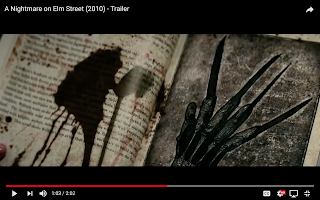I believe that the majority of horror films follow the conventions of the genre to create more chilling and horrific film that the audience will enjoy.
Characters/ Scenes
1. A possessed character, item or monster.
Most horror movies focus around this convention, because the items used are usually found in every common household, causing the demographic to be more frightened, the same thing applies when a human is possessed as the audience begins to fear if this would happen in real life. A monster of some sort (a spirit, a killer or a creature) is always used as the thing that is the source of the terror or fear inflicted on the characters.
2. A religious figure, ie priest.
This character is often used to solve the horrific problem, usually possessions by performing an exorcism.
3. Jumpscares.
These are filmed to leave the audience shook and terrified after a painful moment of silence or a scene lacking action.
Shots/ Cuts
Shots that contain horrifying material are usually edited together with quick cuts to depict a constant feeling of fear and the idea that the characters are always being terrified, these are prevalent especially in chase scenes. Other scenes that consist of normal everyday actions or conversations between characters are edited in the normal way, the technique that is used in all films.
Setting
Trailers in this genre usually have the setting of an abandoned or haunted house to make the audience feel unsettled at the idea that something as average as houses could be the source of the character's terror, along with this the idea that all these terrible things are happening in or because of the house, it gives the idea of endless horror and hopelessness for the characters.
Graveyards are popular for movies containing the undead like zombies or vampires, as they in general are places people like to avoid, and in the movies are usually locked at night and obscured by thick mist, to create suspense.
Woodland or Forests are popular for movies with monsters that come from nature, like a swamp monster or werewolves. They are used because they are huge and the protagonist(s) usually find it difficult to navigate in them. Along with this, the trees are used as camouflage for the monsters and also provide difficulty when characters are running, as they have to dodge in and out of the trees to escape, diegetic sounds like the snap of a branch or the crunch of leaves are emphasized or singled out amongst silence, creating moments of suspense or tension as they alert the monster of the location of the character(s).
Lighting
The lighting in these trailers is almost always low key, as most of the scary things occur in the darkness or at night time. Scenes that depict daytime use high key lighting from the sun to make the scenes look realistic.
Characters/ Scenes
1. A possessed character, item or monster.
Most horror movies focus around this convention, because the items used are usually found in every common household, causing the demographic to be more frightened, the same thing applies when a human is possessed as the audience begins to fear if this would happen in real life. A monster of some sort (a spirit, a killer or a creature) is always used as the thing that is the source of the terror or fear inflicted on the characters.
2. A religious figure, ie priest.
This character is often used to solve the horrific problem, usually possessions by performing an exorcism.
3. Jumpscares.
These are filmed to leave the audience shook and terrified after a painful moment of silence or a scene lacking action.
Shots/ Cuts
Shots that contain horrifying material are usually edited together with quick cuts to depict a constant feeling of fear and the idea that the characters are always being terrified, these are prevalent especially in chase scenes. Other scenes that consist of normal everyday actions or conversations between characters are edited in the normal way, the technique that is used in all films.
Setting
Trailers in this genre usually have the setting of an abandoned or haunted house to make the audience feel unsettled at the idea that something as average as houses could be the source of the character's terror, along with this the idea that all these terrible things are happening in or because of the house, it gives the idea of endless horror and hopelessness for the characters.
Graveyards are popular for movies containing the undead like zombies or vampires, as they in general are places people like to avoid, and in the movies are usually locked at night and obscured by thick mist, to create suspense.
Woodland or Forests are popular for movies with monsters that come from nature, like a swamp monster or werewolves. They are used because they are huge and the protagonist(s) usually find it difficult to navigate in them. Along with this, the trees are used as camouflage for the monsters and also provide difficulty when characters are running, as they have to dodge in and out of the trees to escape, diegetic sounds like the snap of a branch or the crunch of leaves are emphasized or singled out amongst silence, creating moments of suspense or tension as they alert the monster of the location of the character(s).
Lighting
The lighting in these trailers is almost always low key, as most of the scary things occur in the darkness or at night time. Scenes that depict daytime use high key lighting from the sun to make the scenes look realistic.









